Life and Art
1920s – 1950s
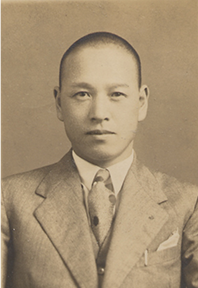 Lee Ungno in his twenties
Lee Ungno in his twenties
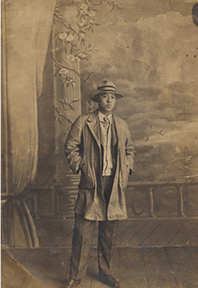 Lee Ungno in Jeonju in his thirties
Lee Ungno in Jeonju in his thirties
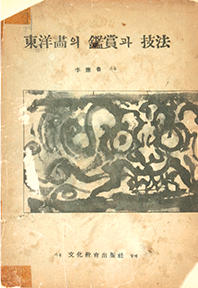 Cover of Oriental Painting Techniques & Its Appreciation, written in 1956 by Lee Ungno
Cover of Oriental Painting Techniques & Its Appreciation, written in 1956 by Lee Ungno
In 1922, Lee Ungno began studying painting under Kim Gyujin (nicknamed Haegang), a literati painter prominent in Korea from the late nineteenth to the early twentieth century. In 1924, Lee made his debut with the painting Blue Bamboo, which was selected for the third Joseon Art Exhibition.
In 1935, Lee sailed to Japan, where he joined the Denko Painting Workshop, run by Matsubayashi Keigetsu, one of the foremost Nanga School artists of the twentieth century. He also studied nihonga and Western painting techniques at the Kawabata Painting School and Hongo Painting Studio, respectively. Then, in 1945, he returned to Seoul and co-founded the art collective Danku in partnership with other young artists, including Jang Woosung, Lee Yutae, and Kim Young-ki. Together, they aimed to revive Korean art, breaking away from Japanese influence. The paintings Lee produced during this period, such as Drunken Night and Street Girls, suggested a modern form of Korean painting.
In addition to his work as an artist, Lee was a devoted teacher. He opened Goam Studio in Seoul to teach painting, and he lectured regularly at Hong-ik University and the Seorabol University of Art. In 1956, he wrote the book Oriental Painting Techniques & Its Appreciation, which contained the principal techniques of Eastern painting. He emphasized drawing or painting based on the painter’s own vision of an object or landscape, as opposed to copying the conventional idealized formats of traditional painting. In the 1950s, he began to produce semi-abstract or abstract paintings.
Lee’s paintings from the 1950s
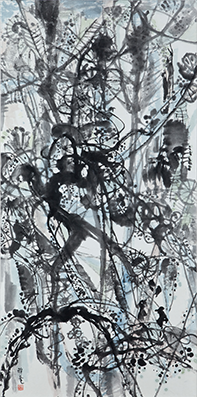 Landscape, 1950, ink and wash on paper, 133x68cm
Landscape, 1950, ink and wash on paper, 133x68cm
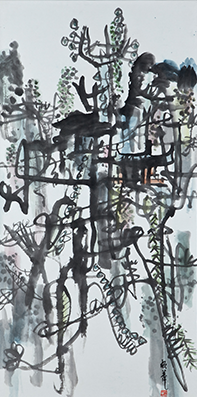 Landscape, 1950, ink and wash on paper, 133x68cm
Landscape, 1950, ink and wash on paper, 133x68cm
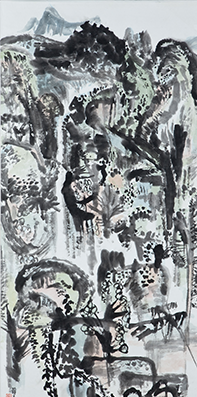 Landscape, 1950, ink and wash on paper, 133x68cm
Landscape, 1950, ink and wash on paper, 133x68cm
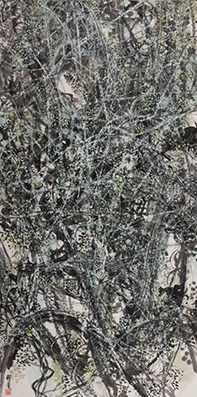 Pulse, 1950, ink and wash on paper, 133x68cm
Pulse, 1950, ink and wash on paper, 133x68cm
1960s, in Paris
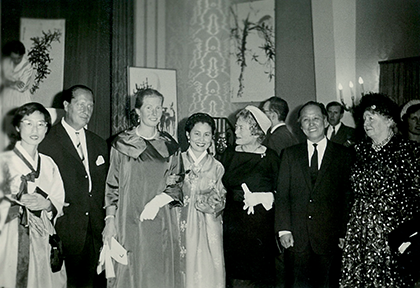 From Lee’s one-man-show at the Musenhof Clubhaus, in Cologne
From Lee’s one-man-show at the Musenhof Clubhaus, in Cologne
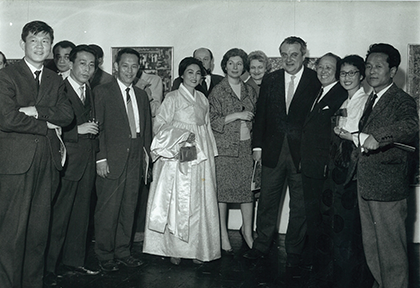 From Lee’s first solo exhibition at the Galerie Facchetti, in Paris
From Lee’s first solo exhibition at the Galerie Facchetti, in Paris
French art critic Jacques Lassaigne asked Lee to visit France in 1956, and in 1958, at the age of 51, Lee departed for Paris. A year later, he travelled to Germany and stayed there for a year, holding solo shows and duo exhibitions with his wife, Park Inkyung, in parts of Germany such as Bonne, Frankfurt, and Cologne. During this period, Lee developed a new painting style, which he came to call ‘semi-abstraction.’ After their one-year stay, the couple returned to Paris and were struck by Art Informel, a major art movement in France famous for its rejection of conventional painting style. Lee combined the unidiomatic language of Art Informel with traditional ink brushworks to create a new style of abstract painting suffused with Eastern sentiments. In 1962, he made a contract with the Galerie Facchetti, which backed Art Informel artists. Lee’s first solo show at the gallery, entitled ‘Lee Ungno: Collage,’ displayed a large series of abstract works made using collage techniques. The exhibition was received favourably by many local critics, many of whom, including Jacques Lassaigne, were in attendance. Subsequently, Lee displayed his work at more than fifty solo or group exhibitions around the world in countries such as Germany, the United States, Switzerland, Italy, Denmark, Belgium, Greece, the United Kingdom, and Japan.
Lee’s collage paintings, done during the 1960s
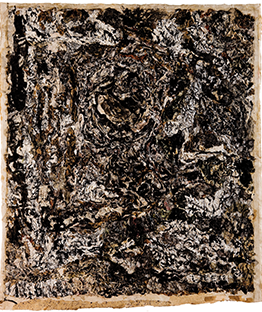 Composition, 1962, paper collage on canvas, 77x64cm
Composition, 1962, paper collage on canvas, 77x64cm
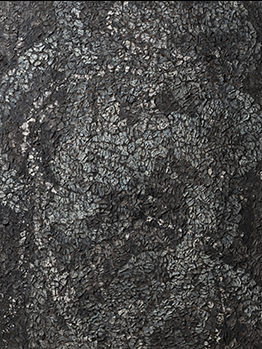 Composition, 1961, hanji (Korean traditional paper) collage on fabric, 116x89cm
Composition, 1961, hanji (Korean traditional paper) collage on fabric, 116x89cm
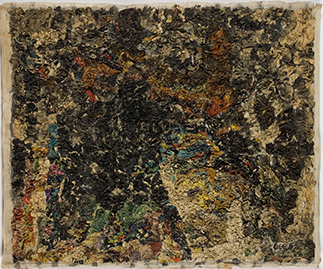 Composition, 1962, paper collage on canvas, 64x75cm
Composition, 1962, paper collage on canvas, 64x75cm
The Academy of Oriental Painting in Paris
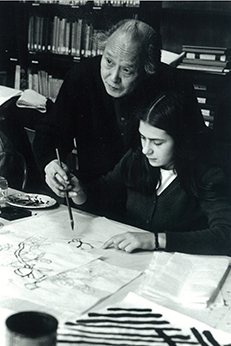 Lee teaching a French student
Lee teaching a French student
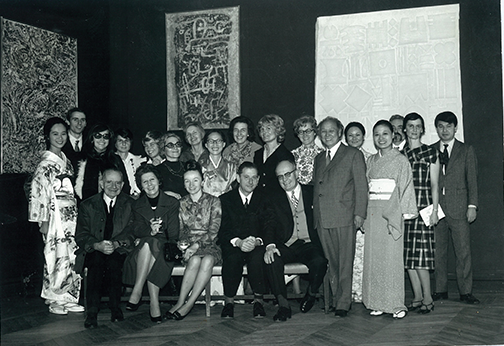 Lee and others at the opening event of an exhibition of works by students from the Academy of Oriental Painting in Paris, 1971
Lee and others at the opening event of an exhibition of works by students from the Academy of Oriental Painting in Paris, 1971
In 1964, Lee co-founded The Academy of Oriental Painting in Paris with Vadim Elisseeff, Director of the Museum Cernuschi, to expand the presence of Eastern painting in Europe. Lee taught the basic principles of Eastern ink painting to local students and regularly held field trips, giving his students the opportunity to train themselves in painting natural objects and landscapes. The Academy was supported by many figures in the French art world, including Alvard (art critic), Hartung (painter), J. Keim (historian), J. Lassaigne (critic), Soulage (painter), Chang Dai Chien (painter), Chou Ling (philosopher), Fujita (painter), Li Hi Soung (linguist), Mei Thu (painter), K. Tchang (philosopher), and Zao Wouki (painter). In 1978, Lee’s book L’art de Peindre à L’encre de Chine (The Art of Chinese Ink Painting) was published.
Paintings from Lee’s Abstract Letter series, produced in the 1960s
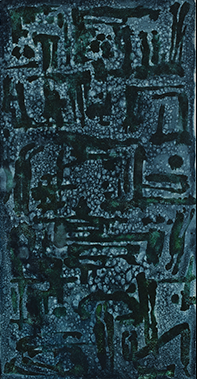 Composition, 1962, oil on canvas, 133x70cm
Composition, 1962, oil on canvas, 133x70cm
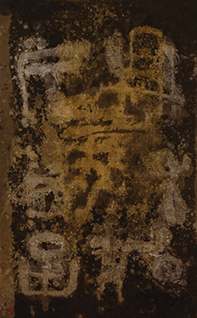 Composition, 1964, colour on canvas, 88x57cm
Composition, 1964, colour on canvas, 88x57cm
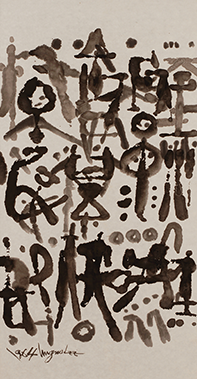 Composition, 1964, ink on hanji, 130x67cm
Composition, 1964, ink on hanji, 130x67cm
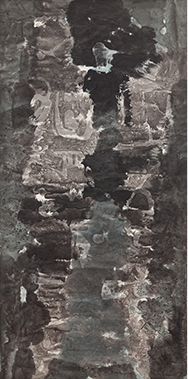 Composition, 1968, ink and wash on hanji, 140x71cm
Composition, 1968, ink and wash on hanji, 140x71cm
1970s: Imprisonment and Breakthrough
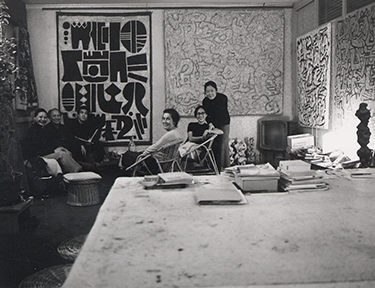 Lee with family and acquaintances at his studio
Lee with family and acquaintances at his studio
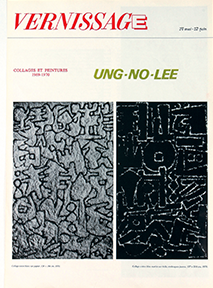 Poster for Lee’s first solo show at the Galerie Facchetti, 1971
Poster for Lee’s first solo show at the Galerie Facchetti, 1971
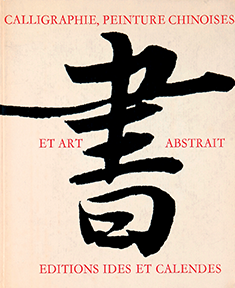 Cover of Calligraphie, Peinture Chinoises et Art Abstract (Calligraphy, Chinese Painting & Abstract Art), co-authored by Lee and Swiss aesthete Pierre Jacquillard
Cover of Calligraphie, Peinture Chinoises et Art Abstract (Calligraphy, Chinese Painting & Abstract Art), co-authored by Lee and Swiss aesthete Pierre Jacquillard
In 1967, Lee Ungno was recalled to Korea and imprisoned for two and a half years for his involvement in the East Berlin Affair. During his imprisonment, Lee worked continuously, and the number of his works rose above three hundred. After his release in 1969, Lee returned to France and created a series of prints Offset, and, in 1970, participated in an opening exhibition of the Sables Museum in Barcarés, displaying an enormous tower sculpture placed on a beach. In addition, Lee was commissioned by the Mobilier National in Paris to produce designs for tapestries, and he collaborated with the National Manufacture in Sèvres. In the first half of the 1970s, Lee refined his Abstract Letter series while holding solo or group exhibitions in the UK, Italy, Belgium, and the US. Lee’s Abstract Letter paintings from this period emphasized the angular and architectural structure of a written letter over the smooth strokes associated with calligraphy.
Works from the 1970s
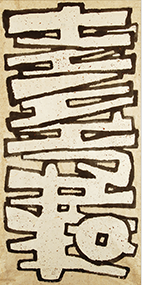 Life, 1972, ink and collage on hanji, 272x132cm
Life, 1972, ink and collage on hanji, 272x132cm
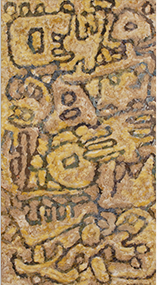 Composition, 1970, cotton wool on hanji, 120x65cm
Composition, 1970, cotton wool on hanji, 120x65cm
 In Prison, 1968, ink and soy sauce on hanji, 130x33cm
In Prison, 1968, ink and soy sauce on hanji, 130x33cm
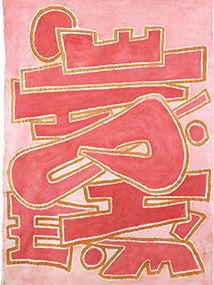 Composition, 1972, colour on cotton flannel, 220x167cm
Composition, 1972, colour on cotton flannel, 220x167cm
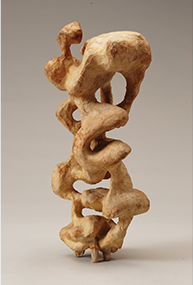 Composition, 1974, paper, 52x20x16cm
Composition, 1974, paper, 52x20x16cm
1980s: Lee Ungno and People
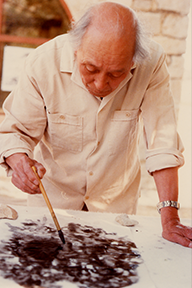 Lee at work, 1981
Lee at work, 1981
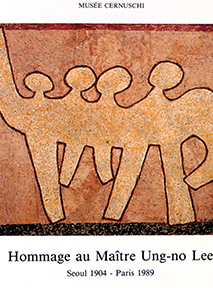 Catalogue cover for an exhibition in tribute to Lee Ungno, held at the Museum Cernuschi, 1989
Catalogue cover for an exhibition in tribute to Lee Ungno, held at the Museum Cernuschi, 1989
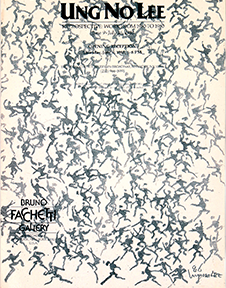 Catalogue cover for a retrospective of Lee Ungno, held at the Galerie Bruno Facchetti, New York, 1988
Catalogue cover for a retrospective of Lee Ungno, held at the Galerie Bruno Facchetti, New York, 1988
The human form played a key role in Lee Ungno’s works. His representation of it evolved throughout his career, in combination with his calligraphic brushworks: During the 1960s, it was expressed as part of nature; during the 1970s, it was transformed into a letter-like form. Lee’s People series, produced from 1980 until his death in 1989, was the highlight of Lee’s artistic career, expressing his philosophies of life and art. In January, 1989, Lee died of a heart attack shortly before the opening of his retrospective at the Hoam Art Gallery in Seoul. He was buried in Père Lachaise Cemetery. Tribute exhibitions for Lee Ungno were held in a number of cities, including Paris, New York, Tokyo, and Osaka. His works are held in the collections of the world’s finest museums, including the Museum of Modern Art in New York, Pompidou in Paris, the National Museum of Decorative Art in France, as well as other galleries in Switzerland, Denmark, Italy, the UK, Taiwan, and Japan.
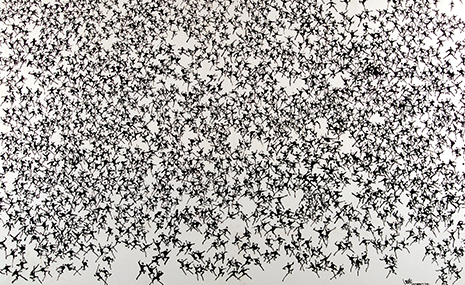 1986, ink on hanji, 167x266cm
1986, ink on hanji, 167x266cm
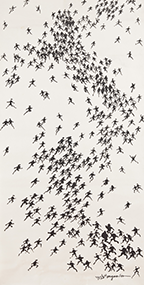 1988, ink on hanji, 130x70cm
1988, ink on hanji, 130x70cm